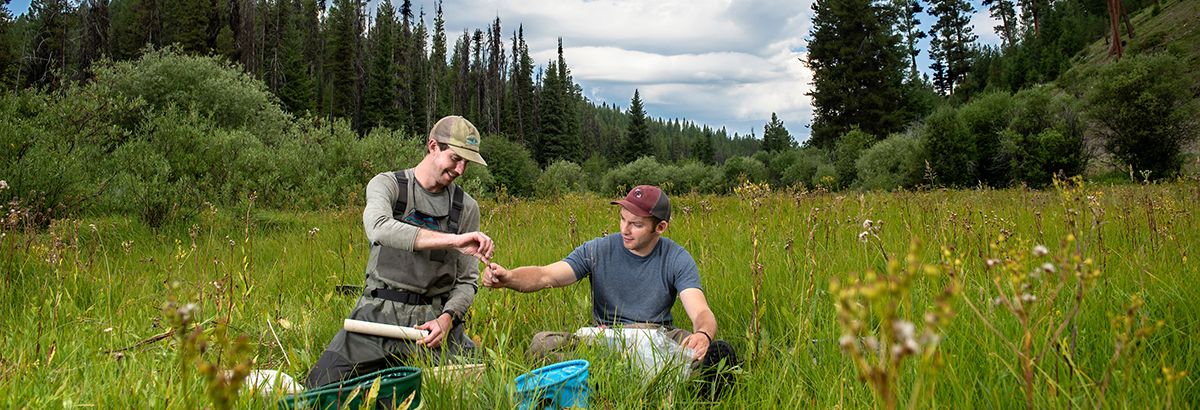Student Spotlight: Simon Buzzard

In Episode 64 of Confluence, we hear from Simon Buzzard, a student in the environmental studies department. Simon shares about his research and hands-on experience with conservation, and how he enjoyed creating his own course of study to fulfill his academic interests and needs.
Story Transcript
I grew up having this real strong interest in wildlife, but in my undergrad I never really pursued wildlife biology or hands-on science. I went to University of Oregon and studied international studies with a focus on community development. Moving to Montana, you know, I wanted to get some background in, wildlife biology, so, environmental studies was a way to combine my interests in the outdoors international conservation issues.
My name is Simon Buzzard, and I studied Environmental Studies—the master's program in Environmental Studies.
My thesis work and my current work, it was basically an idea to combine hands-on conservation projects. So, getting out on the landscape, yeah, working with landowners to improve habitat for wildlife. As well as looking at a data need. There's this gap in landscapes. We don't have a good way of mapping fences. And fences are—can be problems for, for wildlife moving across the landscape. So, there's an effort to think about connectivity in a landscape-scale approach, and you know, roads are a big, big area that's received a lot of attention cause they can, you know, present this stark physical barrier or division of landscape and fragment different habitat. But fences are kind of, a little bit less studied, a little bit less known about their effects on different species. So, you know, working on a fence and improving a fence, making it work for a landowner and wildlife is kind of a, a win-win for wildlife and people.
Southwest Montana is an interesting area because it's, you know, there's relatively few people. lot of open space. So, we have, in some cases, large migrations or long migrations for different species like pronghorn starting to see that they move between Montana and Idaho in that region. been well known for a long time that elk are, you know, having these big migrations in and out of Yellowstone National Park. There are movements of grizzly bears and wolves in that region that span long distances. In my research, I mapped, I kind of reproduced a method to map fences in two counties in southwest Montana. And I actually went and collected data on fences in the region to analyze how good of a map I made. So, it was sort of a predictive model using GIS. A next step further was to take a sample of my study area and actually map fences by hand in Google Earth as a way to see, like, how accurate is it to just go out and hand digitize aerial photography, satellite imagery. So, I have that as well as, you know, looking at satellite imagery and for hours and hours drawing fence lines was part of it as well.
And then I went back and actually interviewed folks on the ground at the BLM, Montana Fish, Wildlife, and Parks, and some landowners, and U.S. Forest Service, and other folks working in southwest Montana to ask them, you know, can we develop assumptions about where fences are on the landscape. I think that we have a really amazing opportunity in Montana that you know, we have these large populations of wildlife that traverse our public and private lands. And I feel like that's part of sort of the Montana identity is that there's these working landscapes that help maintain wildlife populations and that, you know, if the whole Madison Valley or Gallatin Valley were subdivided, we would lose that open space. So, that's why in general, I think it's important to me is that to work on something that helps maintain this landscape into the future for wildlife, and especially when we think about the potential impacts of climate change and, and different stressors that are, are going to occur for wildlife species, you know, it may, it may be a reality that certain species need to move more often than they do now to find food and resources.
The faculty and Ñý¼§Ö±²¥ are, are really motivated group of people. A really dedicated a group of people. And, I kind of came in to the program—I knew kind of exactly what I wanted to do and that I think environmental studies program helps people like me do that. Where if you have a sense of what you're interested in, you can, you know, put together a course of study across different disciplines to make that happen. I took courses in, you know, geography and wildlife biology and statistics and environmental law. All of those things I was interested in and then I could fill in other courses with things that were specific my research. And so that, that's the unique part of environmental studies for me. I appreciate the support in, creating a program of study that's not, it doesn't fit into one specific thing.
